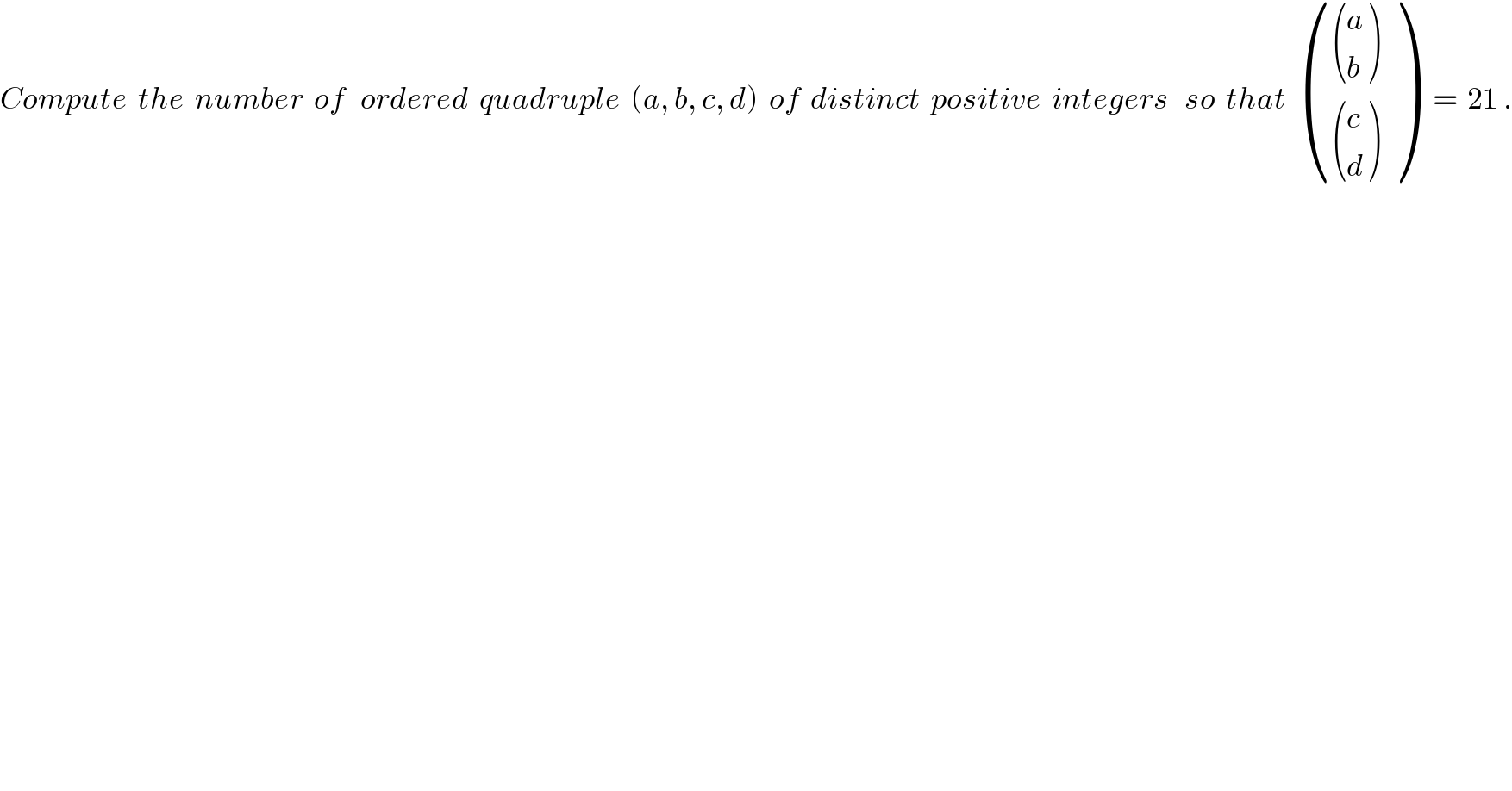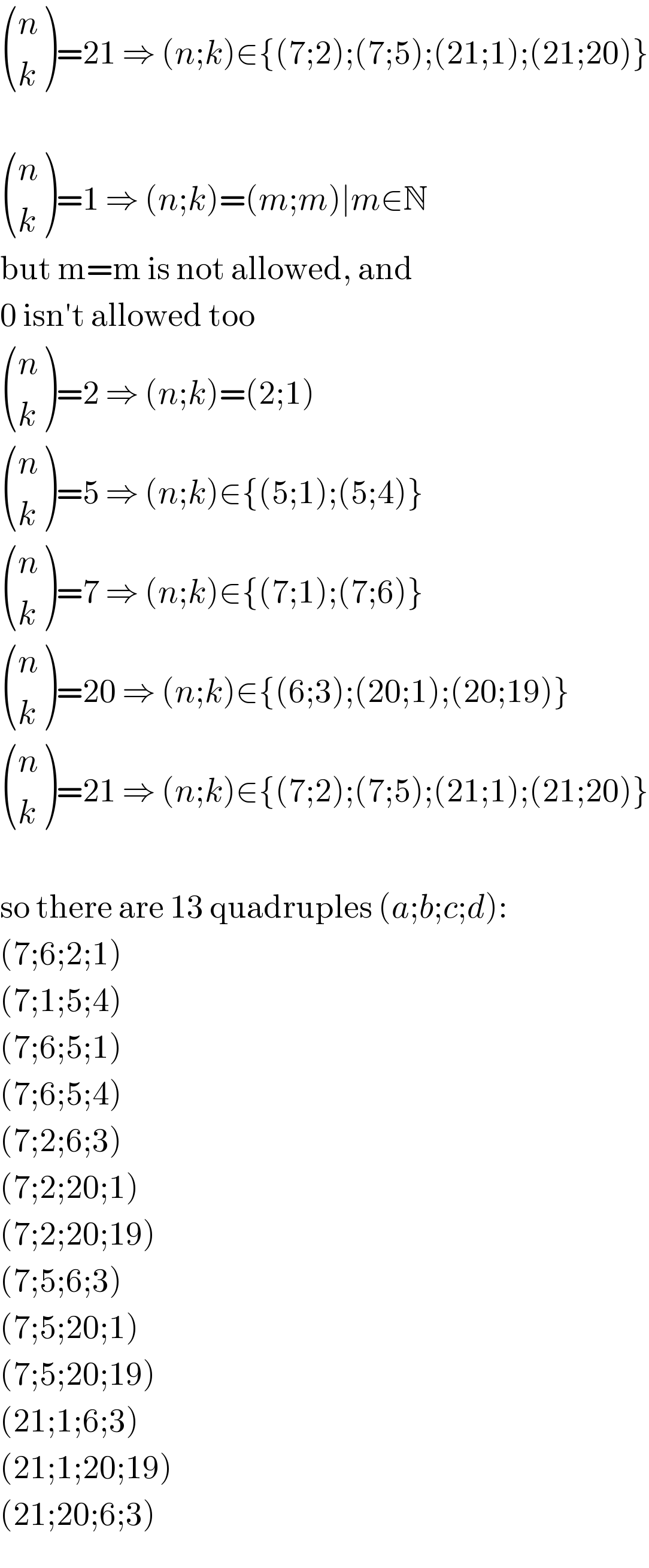Question Number 32569 by naka3546 last updated on 28/Mar/18

$${Compute}\:\:{the}\:\:{number}\:\:{of}\:\:\:{ordered}\:\:{quadruple}\:\:\left({a},\:{b},\:{c},\:{d}\right)\:\:{of}\:\:{distinct}\:\:{positive}\:\:{integers}\:\:\:{so}\:\:{that}\:\:\begin{pmatrix}{\begin{pmatrix}{{a}}\\{{b}}\end{pmatrix}}\\{\begin{pmatrix}{{c}}\\{{d}}\end{pmatrix}}\end{pmatrix}\:\:\:=\:\:\mathrm{21}\:. \\ $$
Commented by MJS last updated on 28/Mar/18

$$\begin{pmatrix}{{n}}\\{{k}}\end{pmatrix}=\mathrm{21}\:\Rightarrow\:\left({n};{k}\right)\in\left\{\left(\mathrm{7};\mathrm{2}\right);\left(\mathrm{7};\mathrm{5}\right);\left(\mathrm{21};\mathrm{1}\right);\left(\mathrm{21};\mathrm{20}\right)\right\} \\ $$$$ \\ $$$$\begin{pmatrix}{{n}}\\{{k}}\end{pmatrix}=\mathrm{1}\:\Rightarrow\:\left({n};{k}\right)=\left({m};{m}\right)\mid{m}\in\mathbb{N} \\ $$$$\mathrm{but}\:\mathrm{m}=\mathrm{m}\:\mathrm{is}\:\mathrm{not}\:\mathrm{allowed},\:\mathrm{and} \\ $$$$\mathrm{0}\:\mathrm{isn}'\mathrm{t}\:\mathrm{allowed}\:\mathrm{too} \\ $$$$\begin{pmatrix}{{n}}\\{{k}}\end{pmatrix}=\mathrm{2}\:\Rightarrow\:\left({n};{k}\right)=\left(\mathrm{2};\mathrm{1}\right) \\ $$$$\begin{pmatrix}{{n}}\\{{k}}\end{pmatrix}=\mathrm{5}\:\Rightarrow\:\left({n};{k}\right)\in\left\{\left(\mathrm{5};\mathrm{1}\right);\left(\mathrm{5};\mathrm{4}\right)\right\} \\ $$$$\begin{pmatrix}{{n}}\\{{k}}\end{pmatrix}=\mathrm{7}\:\Rightarrow\:\left({n};{k}\right)\in\left\{\left(\mathrm{7};\mathrm{1}\right);\left(\mathrm{7};\mathrm{6}\right)\right\} \\ $$$$\begin{pmatrix}{{n}}\\{{k}}\end{pmatrix}=\mathrm{20}\:\Rightarrow\:\left({n};{k}\right)\in\left\{\left(\mathrm{6};\mathrm{3}\right);\left(\mathrm{20};\mathrm{1}\right);\left(\mathrm{20};\mathrm{19}\right)\right\} \\ $$$$\begin{pmatrix}{{n}}\\{{k}}\end{pmatrix}=\mathrm{21}\:\Rightarrow\:\left({n};{k}\right)\in\left\{\left(\mathrm{7};\mathrm{2}\right);\left(\mathrm{7};\mathrm{5}\right);\left(\mathrm{21};\mathrm{1}\right);\left(\mathrm{21};\mathrm{20}\right)\right\} \\ $$$$ \\ $$$$\mathrm{so}\:\mathrm{there}\:\mathrm{are}\:\mathrm{13}\:\mathrm{quadruples}\:\left({a};{b};{c};{d}\right): \\ $$$$\left(\mathrm{7};\mathrm{6};\mathrm{2};\mathrm{1}\right) \\ $$$$\left(\mathrm{7};\mathrm{1};\mathrm{5};\mathrm{4}\right) \\ $$$$\left(\mathrm{7};\mathrm{6};\mathrm{5};\mathrm{1}\right) \\ $$$$\left(\mathrm{7};\mathrm{6};\mathrm{5};\mathrm{4}\right) \\ $$$$\left(\mathrm{7};\mathrm{2};\mathrm{6};\mathrm{3}\right) \\ $$$$\left(\mathrm{7};\mathrm{2};\mathrm{20};\mathrm{1}\right) \\ $$$$\left(\mathrm{7};\mathrm{2};\mathrm{20};\mathrm{19}\right) \\ $$$$\left(\mathrm{7};\mathrm{5};\mathrm{6};\mathrm{3}\right) \\ $$$$\left(\mathrm{7};\mathrm{5};\mathrm{20};\mathrm{1}\right) \\ $$$$\left(\mathrm{7};\mathrm{5};\mathrm{20};\mathrm{19}\right) \\ $$$$\left(\mathrm{21};\mathrm{1};\mathrm{6};\mathrm{3}\right) \\ $$$$\left(\mathrm{21};\mathrm{1};\mathrm{20};\mathrm{19}\right) \\ $$$$\left(\mathrm{21};\mathrm{20};\mathrm{6};\mathrm{3}\right) \\ $$
